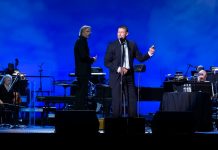A 1995 Gardena High School graduate and Gardena native is serving aboard USS Essex (LHD 2), the largest of all amphibious warfare ships and resembles a small aircraft carrier.
Petty Officer 1st Class Edward B. Hearn is an air traffic controller aboard the San Diego-based WASP-class amphibious assault ship that is nearly as long as 3 football fields at 844 feet. The ship is 106 feet wide and weighs more than 40,650 tons. Two geared steam turbine engines can push the ship through the water at more than 24 mph.
A 1995 Gardena High School graduate and Gardena native is serving aboard USS Essex (LHD 2), the largest of all amphibious warfare ships and resembles a small aircraft carrier.
Petty Officer 1st Class Edward B. Hearn is an air traffic controller aboard the San Diego-based WASP-class amphibious assault ship that is nearly as long as 3 football fields at 844 feet. The ship is 106 feet wide and weighs more than 40,650 tons. Two geared steam turbine engines can push the ship through the water at more than 24 mph.
USS Essex (LHD 2) is fifth ship to bear the name Essex. It is named after a town and county in Massachusetts which is significant because of the tie in with the people of Essex County in 1798 and the building of the first USS Essex.
As a 37 year old with numerous responsibilities, Hearn said he joined the Navy to get away from a tough neighborhood. “People were dropping out of school. I didn’t want that and the Navy seemed like a good fit,” said Hearn. “I thought I would only serve four years and get out. Now I am at 19 years.”
He also said he is proud of the work he is doing as part of the Essex’s 1200-member crew, protecting and defending America on the world’s oceans. “With world events that are happening we are geared up with Marines on board to be able to carry out any mission set out by the President of the United States,” said Hearn.
Sailors’ jobs are highly varied aboard USS Essex. Approximately 73 officers, 1109 enlisted men and women make up the ship’s company, which keeps all parts of the ship running smoothly — this includes everything from washing dishes and preparing meals to handling weaponry and maintaining the engines. Another 1800 or so form the Marine Corps Marine Expeditionary Unit (MEU) and Essex is capable of transporting the MEU and landing them in hostile territory via landing craft or helicopters.
“USS Essex is truly a fine warship and the crew that mans her is second to none,” said Capt. Peter Mantz, the ship’s commanding officer. “The sailors and Marines of Essex have been working diligently to prepare this warship, and I feel an unparalleled sense of pride working alongside our nation’s finest sailors and Marines.”
The principle mission of Essex is to conduct prompt, sustained operations at sea, primarily as the centerpiece and flagship of the Amphibious Ready Group. Essex provide the means to transport, deploy, command and support all elements of a Marine landing force of over 1,800 troops during an assault by air and amphibious craft.
Designed to be versatile, Essex has the option of simultaneously using helicopters, Harrier jets, and Landing Craft Air Cushioned (LCAC), as well as conventional landing craft and assault vehicles in various combinations. Because of their inherent capabilities, these ships have been and will continue to be called upon to also support humanitarian and other contingency missions on short notice.
As a member of one of the U.S. Navy’s largest amphibious assault ships, Hearn and other Essex sailors are proud to part of a warfighting team that readily defends America at all times.
“I would definitely recommend the military as a good starting bock for getting started in life,” said Hearn. “You can go to college, have medical and dental benefits.”



















